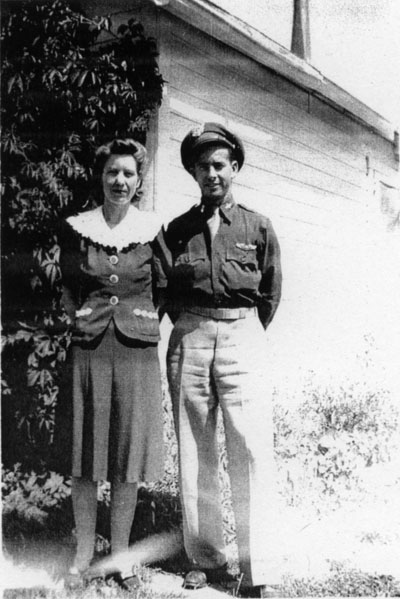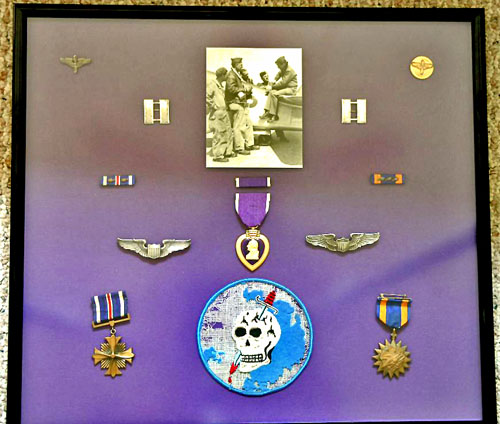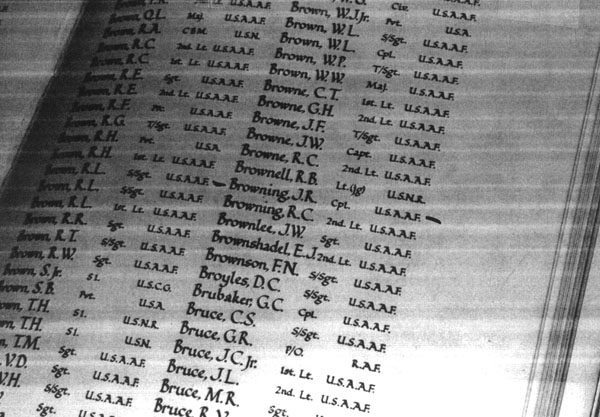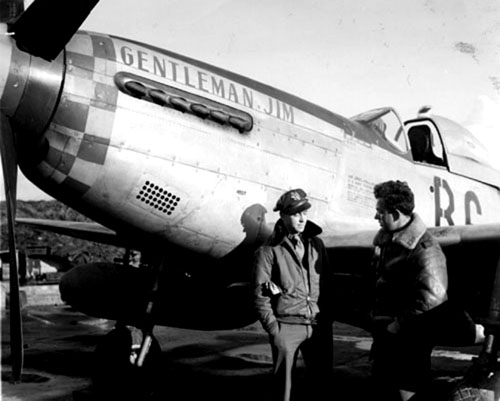
Kathryn and Jim Browning (May be the last Stateside Photo taken of Jim in Denver, Colorado, Fall 1944.)
Collection of WWII era newspaper stories saved by Jim Browning’s sister Kathryn (Browning) Puckett. (I decided to type these for easier reading)
Browning Duels with German FW-190, June 30 1944
An Eighth AAF Figher Station, England – “Gentleman Jim,” the P-51 Mustang piloted by Capt. James W. Browning, Syracuse, Kansas, lived up to its name in a recent air duel with a gaily decorated German FW-190 near Magdeburg, Germany. After chasing the silver-colored, black and yellowed striped 190 from the tail of a Mustang, “Gentleman Jim” delivered the fatal punch to the German plane and gave its pilot an opportunity to bail out.
Capt. Browning describes the duel: “I was circling at 8,000 with my wingman watching for any friendly aircraft in trouble. Suddenly I saw a buddy on the tail of a Jerry with another Jerry chasing on the Mustang’s tail. I chased the second Jerry away and to the deck. I followed him 30 miles at tree top level, my bullets turning his plane into a flying sieve. I saw he was ready to toss in the towel, so I pulled up. He rolled out and believe it or not, my wingman saw the German’s chute open. His plane plunged into the ground and scattered it’s flaming remains over a 100 yard area.”
Captain Browning’s wife, the former Marcellyn Lee Taylor and son, Leslie 3, live in Lyons, Kansas. The flyer’s mother, Mrs. Sidnie Browning, resides in Syracuse.
Captain James Browning Home From England Aug 25, 1944
Captain James Browning, pilot of a Mustang P-51 on 75 missions and for over 300 hours, is home from England on a thirty day furlough. Captain Browning and his wife and son arrived last Saturday from Lyons and expect to be in Syracuse for about two weeks visiting with their mother, Mrs Sidnie Browning and other relatives and friends.
Captain Browning has five German planes to his credit and shares honors on two other with other members of his fighter group. He has been awarded the Distinguished Flying Cross and One Oak Leaf Cluster and the Air Medal with three Oak Leaf Clusters.
At the time he left England Browning says that his fighter group has shot down 310 planes and by this time they “probably have a lot more…after the first few missions instead of asking ‘did you get any’, you were asked how many did you get?”
It is the fighter planes duty to protect the bombers and about 50 escort planes escort a group of 250 bombers. They usually fly above and to the each side of the bomber formation. Browning says that enemy planes are quickly spotted by the fighters as they do not fly like Americans. They almost invariably fly in close formation and when attacked it is not at all unusual for them to leave without putting up a fight. “If more of them would fight, probably they could shoot down more American planes, but usually they will run off or the pilots will bail out.” In one fight which Browning was engaged the German pilot bailed out and when the parachute snapped open it threw him out. “The Germans are afraid of the Mustangs, because they can fly farther and fight longer than any German plane. Almost all the German planes have belly gas tanks, and when engaged in a fight they get rid of these because a hit on them means the plane goes up in smoke. Consequently, their plane soon runs out of gas.”
On D day, Captain Browning and another of the fighter pilots from his base became lost when they were returning from their mission. They thought that they were over English soil and started to loose altitude and circle, “when we got down to about 3000 feet someone started to shoot at us, and when we thought those darn Englishmen were shooting at their own men, then we found out that we hadn’t crossed the channel yet and were over Calais, France. The channel is only about 21 miles wide at that point and at 250 miles per hour, that isn’t very far.”
“I have been over Berlin many times and on one mission we were within 200 miles of Warsaw. When bombing a large city such as Berlin, the bombers have to fly right through heavy bombardments of flak. It is best described as sounding like you were in a heavy hail storm. It can pierce any plane and if it hits a vital spot you go out of the picture right away. The shells are timed to explode at different altitudes and I’ve never been high enough yet that it couldn’t get to me. You don’t see them until they explode and there’s no way to get away from it. I really thought I had been hit one day, I was climbing up to engage an enemy plane when the canopy of my cockpit came off. It came off with such a loud report, I thought a shell had hit me. We were flying at about 25,000 feet and I couldn’t stay long because of the cold. As soon as I could get away, I headed back to England.”
Modestly describing his part in the war as not being anything at all out of the ordinary, Captain Browning’s wish was that when he gets back to the Eighth Air Force, that he will have as good a plane as his “Gentleman Jim.” “You get used to the feel of them, and I sure hated to leave it behind,” he said.

Display of Jim Browning’s Pilot Wings, Service Medals, Rank and 363rd FS Patch.
Medals From Overseas, July 14, 1944.
The Journal force was given their first good look at the Air Medal and Distinguished Flying Cross Thursday morning when Mrs. Sidnie Browning brought in the ones presented to her son, Captain James Browning. Mrs. Browning received the medals Wednesday from “Jim”, who is stationed in England.
We have always admired such medals from a distance and suppressed a desire to go up to some officer and ask to get a close up, so we took full advantage of this opportunity to inspect them. They are both made of heavy metal that looks like (and probably is) bronze. The Air Medal is round, with sharp points around the edge and an eagle in flight insignia. The Distinguished Flying Cross is just what the name suggests, a replica of a cross, formed by propeller blades.
Of course, Mrs. Browning is quite proud and so are we all, that Hamilton county has a boy who so distinguished himself. Captain Browning has five German planes to his credit and in his letter yesterday stated that he had shot down three more, “I should have had all five, but I got to eager.”
Besides the medals sent to his mother, Captain Browning has three oak leaf clusters which he kept. He did however, send her the bar from which the clusters are suspended, with the explanation that he could get another.
Captain James Browning Kayos another plane. Jan 19, 1945.
An Eighth Air Force Fighter Station, England – “Gentleman Jim,” hitting the Hun where it hurts the most, kayoed his sixth Luftwaffe opponent with six wing gun punches.”
“Gentleman Jim” is an Eighth Air Force P-51 Mustang flown by Captain James Browning of Syracuse, who knocked out the Messerschmitt 109 the afternoon his group downed 20 enemy interceptors over Berlin. The 357th fighter group flight (four aircraft) commander describes his sixth victory: “We met 20-plus ‘bandits’ (enemy aircraft) in a head on pass. I took my time and hit one of them with a number of short bursts as he turned to the left. The plane exploded, collapsed and fell to the earth in pieces.”
The Mustangmen of the 357th commanded by Lt Col. Irwin H. Dregne of Viroqua, Wisc., have destroyed 480 Nazi aircraft in nine months, 458 of these in aerial combat.
The sixth Nazi plane kayoed by Captain Browning was shot down prior to the news story carried in this issue describing a triple kill last week, which would raise his total to nine German planes.
Syracuse Captain Gets Triple Air Kill Jan 19, 1945
London, January 15 – U.S. Eighth Air Force Mustangs and Thunderbolts mad a record kill of 149 enemy planes in air battles over north central German’s oil storage region yesterday.
The victories included: Three German planes in the air – Lt. Chester Maxwell, Alva, Okla. , and Captain James Browning, Syracuse, Kansas. Two in the air – Lt Harley Brown, Wichita, Kansas.
Syracuse Captain Sees V-2 Rocket In Action Jan 2, 1945
London – Berlin radio promised increased bombardment of London with V-2 rockets, declaring “this terror” visited on Britain makes Allied bombing raids on Germany “much more bearable since we know how much the enemy has to suffer.”
Capt. James W. Browning, Syracuse, Kas., Mustang fighter pilot, reported seeing a German V-2 rocket shot into the air during a bomber escort mission over Germany but “it wobbled and arched back towards it’s launchers. I was busy in the air and didn’t have time to fly down to see if boomeranged; pulled a Frankenstein trick. I hope it did.”
Capt. James Browning Missing In Action March 2, 1945
Mrs. Sidnie Browning received a telegram from the war department Wednesday noon advising her that her son, Captain James Browning, was missing in action over Germany on February 9.
Captain Browning was in the Eighth Air Force stationed in England and his P-51 Mustang fighter plane “Gentleman Jim” has destroyed 9 German planes. He was flight commander of the 357th Fighter Group (four aircraft).
He attended the Syracuse public schools and entered the service in May, 1942, receiving his wings at Luke Field, Phoenix, Arizona.
His mother, two brothers, Francis and Donald, four sisters, Mrs Mary Alexander, Mrs J. W. Conard and Miss Lois Browning live in Syracuse. His wife and son Leslie live in Lyons, and another sister. Mrs. Jess Puckett lives in Denver, A brother Clyde, is in the Navy.
Jim Browning Down Near Wurges, Germany
Additional news concerning the death of Captain James Browning. Syracuse ace who, was reported missing during the last days of the European war, was received here Sunday by relatives. The information was obtained from captured German war records and was forwarded in a letter to Mrs Browning by Leon W. Johnson, brigadier general.
Mr. Johnson’s letter said: “On 9 February, 1945, his P-51 (Mustang) fighter was downed about two miles southwest of Wurges, Germany. These records further indicate that his body was recovered by the German, however it is regretted that the time and place of interment is not given.”
The letter added that as recovered bodies are removed to U.S. military cemeteries in liberated countries, and that definite information concerning burial location would be forwarded when received.
Captain Browning, with nine enemy planes to his credit, was Hamilton county’s only ace. He was a graduate of Syracuse high school and worked here for several years after graduation. He is survived by his widow and son, who now live in California, his mother and several sisters and brothers. The letter received by relatives here, and forwarded to Mrs. Browning, who had left the day before to visit relatives at Crawford, Colo.

Saint Paul’s Cathedral London England
Large book contains all names of allied forces who were KIA in the European theater and based in England. Everyday of the year, a new page is turned to show to the world the sacrifice of so many that kept the world free. Note. The listing as J.R. Browning. The English listed it also James Willy.
All this information was sent by Bill and Kathryn Puckett.

Jim Browning with his crew chief and “Gentleman Jim”

